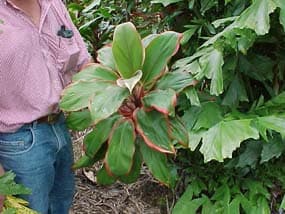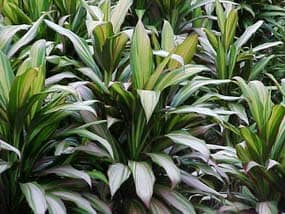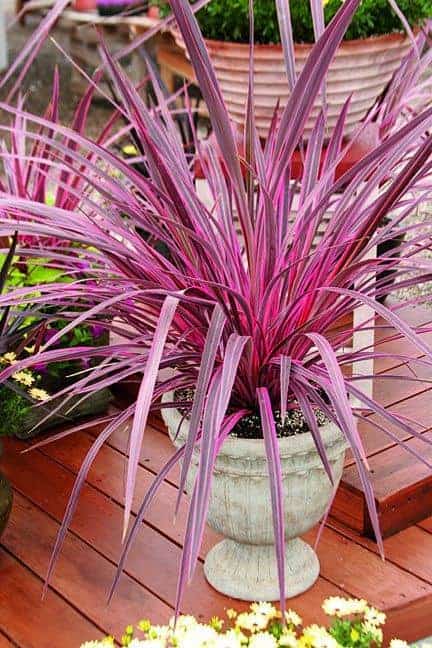Want color in the landscape? Cordyline fruticosa adds color to the landscape around your house whether planted inside growing as houseplants or outside in the garden.
It has about 27 species of Dracaena type plants known for their colorful foliage. Cordyline (Ti plant) comes from the Greek word kordyle, meaning club, and used to refer to enlarged rhizomes.

The leaf colors of the Hawaiian Ti plant range from glossy green to reddish purple to a combo of colors (red, purple, white, or yellow)!
The plant can produce red or yellowish flowers that put off a sweet fragrance. Cordyline plants are woody monocotyledonous flowering plants.
The trunk of this evergreen shrub looks almost “palm like”, usually not branched and can grow 10 feet and more.
Cordyline – Ti Plant Quick Care Tips
- Botanical Name: Cordyline fruticosa
- Common Name(s): Hawaiian Ti plant, Good Luck plant, Ti leaf
- Synonyms: Cordyline terminalis, Dracaena terminalis
- Family & Origin: Asparagaceae family, native to Southeast Asia, the eastern part of Australia, Hawaiian Islands, and the Pacific Islands
- Growability: Easy to grow
- Grow Zone: USDA zones 9-12
- Size: Grow up to 10′ feet tall and 3-4′ feet wide
- Flowering: Produces small, fragrant flowers in summer
- Light: Bright, indirect light or partial shade
- Humidity: Prefers high humidity, mist leaves regularly
- Temperature: Thrives in temperatures between 60-85°F
- Soil: Well-draining soil, slightly acidic
- Water: Keep soil moist but not waterlogged, water when top inch of soil is dry
- Fertilizer: Feed every 2-3 months with a balanced fertilizer
- Pests & Diseases: Susceptible to spider mites, mealybugs, and scale insects. Can also be affected by root rot if overwatered.
- Propagation: Propagated through stem cuttings or by air layering
- Plant Uses: Often used as an ornamental plant in gardens or as a houseplant. The leaves are also used in Hawaiian culture for hula skirts, leis, and other decorations.
Generally, Cordyline fructicosa (sometimes spelled fruiticosa) also know by the botanical name Cordyline terminals [source] exhibit upright growth in shrub form with their unbranched trunk. But sometimes they grow in clumps by suckering from the enlarged tuber-like rhizomes.
Most of us are more familiar with the smaller version as a houseplant prior to the trunk fully developing.

The leaves as stated above come in a variety of colors. They are about 12 to 30 inches in length and about 4 to 6 inches in width.
The flowers the plant produces are ½ inch wide and grow in clusters in 12-inch panicles. The “fruit” comes in the form of berries red in color.
Indoors, Cordyline fruticosa grows as a smaller foliage houseplant. Outdoors, the plant grows as a specimen and accent shrubs.

Sports Of Cordylines
Most of the Ti leaf plant varieties we find in the landscape or used in flora arrangements originate with the species fruiticosa.
Here are a few of the more common varieties currently grown:
- Cordyline fruticosa – glossy leaves that differ in color according to cultivar
- C. ‘Red Sister‘
- C. ‘Schubert’
- C. ‘Xerox’
- C. ‘Peter Buck’
- Cordyline terminalis
- C. ‘Anti-lu’
- C. ‘Black Magic Ti Plant’
- C. ‘Pink Diamond’
- C. ‘Bolero’
- Cordyline Kiwi
- C. Imperalis’ has pinkish red leaves
- C. ‘Amabalis’ has leaves with pink and white spots
- C. ‘Baptisii’ has leaves streaked with pink and yellow
- C. ‘Hybrida’ has leaves with pink margins
- C. ‘Tricolor’ has leaves with bold streaks of green, pink and creamy yellow
- C. ‘Firebrand’ (a.k.a. ‘Red Dracaena’) has reddish purple leaves with paler veins. The more commonly known Dragon Tree plant’) is the more “red dracaena”
- C. ‘Baby Ti’ has coppery leaf margins
- C. ‘Hawaiian Bonsai’ has dark crimson leaves
- C. ‘Margaret Story’ has leaves splashed with copper, red and pink colors

Origin
Cordyline fruticosa most believe the plant origin to be in the city of Papua, New Guinea and Southeast Asia.
It found itself transported through the Pacific Ocean area and the early Polynesians used the rhizomes of the Ti plant as a starchy food source.
NOTE: Dracaena fragrans are sometimes sold as Ti plants but with bright green leaves. Cordyline fruticosa is sometimes sold as Dracaena terminalis.
At present, this plant grows in the eastern part of Australia, Hawaii, and many other islands of the Pacific.
Cordyline Care And Growing Conditions Required
Ti plants grow well in USDA Hardiness Zones 9 – 12. This plant does not like temperatures below 55° degrees Fahrenheit.

This plant likes partial shade to almost full sun. When in full-sun the plant requires more frequent watering. Make sure the growing pot has a drainage hole for the excess water to drain off. Do not allow Cordylines to sit in a saucer of water which can lead to root rot.
If grown as a houseplant, place in a bright spot but no direct sunlight.
NOTE: When watering use distilled water or rain water over tap water. Tap water often contains fluoride which can lead to leaf tips turning brown.
Allow the soil to dry out between watering. Keep air humid (especially indoors) – mist every so often.
Plant propagate easily from stem cuttings. Take a stem from a mature plant and cut it into approximately 3″ to 5″ inch sections.

Remove all leaves and place the cuttings on a layer of sand. This needs heat from the bottom.
The stem’s eyes will grow into shoots. When shoots have about 4 to 6 leaves place in a potting mix.
Other Uses Of Hawaiian Tea Plant
In addition to being a magnificent ornamental plant, parts of the plant are known for their staple value.

The rhizomes, for instance, are high in starch. Most feng shui experts believe that Cordyline fruticosa brings good luck to its owner.
Personal Story of the Ti Plant Black Magic
I’ve been blessed over the years to personally met and become friends with some extraordinary plant people – growers, collectors and landscapers.
One was Jim Talley and amazing landscape designer. Jim had a gift of being able to see a plant(s) or rock and how it naturally fit like a glove in the landscape. The stories I could tell.
Back in the early 1970’s, Jim shared with me this story of Cordyline “Black Magic.”

Back then we always called this “Cordyline Dracaena” – Costa Rican “Black”. It became Jim’s “signature plant” he incorporated into all of his landscape projects.
Costa Rican “Black” was and is a spectacular landscape plant. Long, large leaves (36″ inches 5″-6″ inches wide), emerging green and turning to a deep burgundy, maroon red leaves which look black from a distance. An upright plant reaching 10′-12′ foot tall.
Black is not a color we think of used in the landscape much but it is a show stopper.
Jim traveled to Costa Rica often searching for new plants. Plants he could plant in his field nursery and use on landscape jobs.
Costa Rican “Black” was a “discovery” of his… or so the legend goes.
Traveling through the back roads, visiting small towns or villages in Costa Rica, Jim came upon a hedge about 150 feet long of Costa Rican “Black.” The plant stopped him in his tracks.
Unfortunately, he did not have time to get some cuttings to bring home. He knew he would be back in about 6 weeks, and planned to get some cuttings then.
On his return, the entire stand of Costa Rican “Black” was gone. Cut to the ground, roots gone to make the road wider. Jim searched and searched for a cutting and found a small “piece of cane” which he brought back to propagate.
That small piece of Costa Rican “Black” cane was the beginning of Jim’s landscape signature. It was and is a one of a kind plant.
Jim passed a few years ago along with a wealth of landscape design and plant knowledge passed as well. But his signature plant lives on in – Costa Rican “Black.”
Other Popular Varieties Of Cordyline Plants
Cordyline pumilio (Dwarf cabbage tree)

Cordyline pumilio (Latin for “dwarf”) is known as the Dwarf cabbage tree, Pygmy cabbage tree, Ti koraha or Ti rauriki originates in New Zealand. It’s dwarf habit makes it the smallest of the five Cordyline species which call New Zealand home.
Reaching a height of roughly 3′ feet tall, it seldom forms any type of trunk. First time encounters mistakenly gaze upon long narrow leaves of Cordyline pumilio and assume it is a grass. Grown primarily as a food crop and used by the Maori to sweeten foods. [source]
Cordyline australis “Red Star”
This variety gives great offer great texture and color with sword like burgundy red leaves.
Red Star cordyline looks amazing planted in large patio containers and its upright leaves organized in a spherical fan-like arrangement makes it have a sophisticated look.
Plant red Ti plant in large decorative patio container planted alone or surrounded by bright flowering perennials like Lavender, Mexican Heather, Verbena, Lantana, Canna and silver foliage or as a landscape focal point.
- Over time “Red Star” will develop a trunk, but treat as an annual in cold areas.
- In early summer stems of fragrant white flower appear.
- Grows in partial to full sunlight outside in USDA Hardiness zones 9-11
- Used in the landscape along poolsides, in containers or border accents. Works well in minimalist landscape. Plant alone with decorative rock makes a beautiful statement.
- Easy Care

Cordyline Red Star prefers dry summer conditions and low humidity. In the hotter inland gardens, some partial shade protection might be necessary.
When planting in containers, to accommodate the plant’s long tap root, it is advisable to use a deep container. If growing indoors place “Red Star” next to the brightest window.
Rarely affected by diseases or insects Hawaiian Ti’s do encounter some pests such as plant scale, mealybugs where leaves meet stems, and spider mites on leaf undersides can cause a problem. To treat get rid of pests spray your plants with insecticidal soap spray every 7 to 10 days.
Cordyline Electric Pink
Electric Pink lights up the landscape with vertical, vivid pink leaves that make an outstanding statement. This makes “Electric Pink” an in demandin-demandr its application in landscaping for garden planting as well as a focal plant in patio containers.

The plant offers year round color especially in winterized gardens when the color intensifies.

Once properly established after planting, it is highly tolerant to extreme temperatures.
The tallest plants measured of ‘Electric Pink’ show considerable branching at a heath of about 8 feet tall.
Electric Pink flourishes in direct sun, this also enhances the color of the leaves but plants grow well in light part shade.
It does best in a well-drained soil, fairly drought tolerant in coastal gardens and regular irrigation produces more lush planting. Hardy to around 15° F, growing well in USDA zones 9-10 and generally a reliable plant. Some mealybug infestations seem to cause growth tip damage.
Electric Pink originates from a mutation of species banksii and received US Plant Patent PP19,213 in September 2008.
Cordyline Red Sensation
Red Sensation resembles some species of yucca plants with its sword-like, deep purple-burgundy leaves and white flowers in spring. It is a truly stunning plant that grows well in pots if you cannot to grow it outdoors all year round.
Use Red Sensation as a houseplant or even as a shrub in a garden setting since it can reach an appreciable size as a full grown tree.

Red Sensation is low maintenance and requires good light to retain its color. It does well in properly drained soil and can tolerate alkaline soils. You should never let it dry out but you should reduce the watering in the winter. Cordyline Red Sensation has a preference for full sun but still does well in semi-shade.
Best in full sun to partial shade. Drought tolerant, likes occasional to regular irrigation. Offers a tropical look in dry gardens and makes a great container plant. Hardy to around 15° F.
Looks similar to Red Star but definitely different plants. [source] Compared to ‘Red Star’ this cultivar has slightly wider leaves that are more purple (less red) and have a more green venation (especially prominent on older leaves).
Cordyline Red Sisters Plant
Red Sister Cordyline known as Hawaiian Ti or Red Ti. You’ll find this tropical perennial shrub commonly used for ornamental purposes achieving a height of 6 – 10 feet. It is best known for its distinctive bronze-green and burgundy pink foliage.

The Red Sister plant prefers warm temperatures and bright sunlight for proper growth. It requires regular watering and moist soil with regular fertilizing every 3 months.
Outdoors, it grows in moist soil and partial shade to partial sun conditions for the perfect foliage condition.
You should protect it from light and heat reflected off asphalt and sidewalks. If you want its leaves to have a fresher and slightly glossy complexion, humidity will be necessary.
Add Burgundy To Containers Or Landscape With Cordylines

Cordylines have long been used in the landscape. In recent years they’ve enjoyed somewhat of a revival in not only their use but also the introduction of new varieties. One of these new Ti plant varieties is cordyline “Festival Burgundy.”
Stunning Burgundy strap-like leaves (which I am a fan of), wonderful dark shiny color, make it stand out in any garden planting or mixed container.
It’s round bush shaped form and beautiful cascading foliage makes it versatile for the garden but really stands out when planted in large display pots.
Unique from other Cordylines, Festival™ Burgundy branches from the base to form short, multiple stems which spread from the base to create a sturdy low-growing grass plant, no more than 3 feet tall.
Easy-care, compact and bushy make it an attractive addition to the landscape color pallet and a wonderful new plant for your container gardens.
Growing Cordylines: Care Question & Answers
Hawaiian Ti Plant Leaves Turning Yellow Dropping?
Question: Why do the leaves on my four-year-old Hawaiian ti turn yellow and drop? It receives sunlight and plant food. Caleb, Indiana
Answer: The Ti-plant requires warm, moist growing conditions and light, well-drained soil. While it requires soil that drains quickly it also needs frequent and regular watering.
Water standing at the roots, too dry soil, or excessively dry air will cause the leaves to yellow or leaf tips to brown. See that free water drains away, water often and give small doses of liquid fertilizer high in nitrogen about once a month.
Below is a list of 27 species or Cordyline plant varieties recognized by The World Checklist of Selected Plant Families at Kew as of August 31, 2017.
- Cordyline Comm. – 1810
- Cordyline angustissima – 1905
- Cordyline australis – 1833
- Cordyline banksii – 1860
- Cordyline cannifolia – 1810
- Cordyline casanovae – 1874
- Cordyline congesta – 1840
- Cordyline forbesii – 1923
- Cordyline fruticosa – 1919
- Cordyline × gibbingsiae – 1929
- Cordyline indivisa – 1836
- Cordyline lateralis – 1913
- Cordyline ledermannii – 1925
- Cordyline manners-suttoniae – 1866
- Cordyline × matthewsii – 1927
- Cordyline mauritiana – 1918
- Cordyline minutiflora – 1916
- Cordyline murchisoniae – 1866
- Cordyline neocaledonica – 1893
- Cordyline obtecta – 1875
- Cordyline petiolaris – 1986
- Cordyline pumilio – 1860
- Cordyline racemosa – 1916
- Cordyline rubra – 1848
- Cordyline schlechteri – 1913
- Cordyline sellowiana – 1850
- Cordyline stricta – 1836
Image: source
